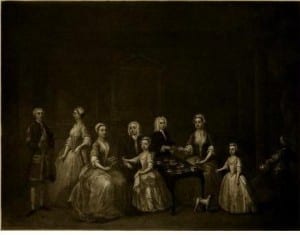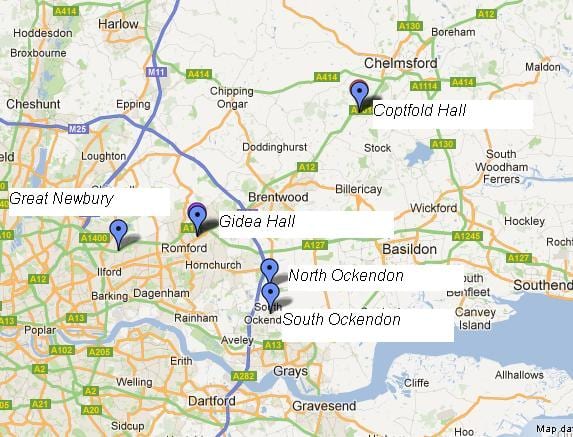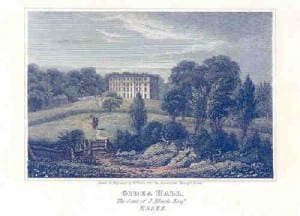 Englefield’s imposing structure stands within rolling grounds near the village of Englefield in Berkshire, on the site of an earlier house, which belonged to the Englefield family. The Englefields surrendered most of the estate in 1585 and the house then remained in varying degrees of splendour until it was inherited in 1712 by Anne Wrighte (née Paulet) from her brother Lord Francis Paulet. At the time, Anne was married to Reverend Nathaniel Wrighte. During their marriage the Wrightes had three sons, the eldest of whom (Powlett Wrighte) inherited Englefield in 1729. Powlett Wrighte (d.1741) augmented his inheritance by marrying well. He tied his own estate to that of the Beauvoirs by marrying the heiress to Rachel Beauvoir’s fortune – Mary Tyssen (d.1776), daughter of Francis Tyssen and Rachel Beauvoir from Hackney in Surrey.[1] The couple had one son, Powlett Wrighte the Younger.
Englefield’s imposing structure stands within rolling grounds near the village of Englefield in Berkshire, on the site of an earlier house, which belonged to the Englefield family. The Englefields surrendered most of the estate in 1585 and the house then remained in varying degrees of splendour until it was inherited in 1712 by Anne Wrighte (née Paulet) from her brother Lord Francis Paulet. At the time, Anne was married to Reverend Nathaniel Wrighte. During their marriage the Wrightes had three sons, the eldest of whom (Powlett Wrighte) inherited Englefield in 1729. Powlett Wrighte (d.1741) augmented his inheritance by marrying well. He tied his own estate to that of the Beauvoirs by marrying the heiress to Rachel Beauvoir’s fortune – Mary Tyssen (d.1776), daughter of Francis Tyssen and Rachel Beauvoir from Hackney in Surrey.[1] The couple had one son, Powlett Wrighte the Younger.
After Powlett Wrighte’s death in 1741, Mary Wrighte remained at Englefield. The estates and lands were held in trust by John Wilder and Daniel May for Mary and her son Powlett, until he came of age in his twenty-first year.[2] In 1745 Mary remarried, to a Richard Benyon (1698-1774) and it is at this point that Englefield House becomes of greater interest to this project. Richard Benyon was rich, and more significantly he had made his money with the East India Company.
Richard Benyon was born in 1698, and fourteen years later, he began his career with the East India Company.[3] Little is known of Benyon’s early life or family connections. In Swallowfield and its Owners (1925), Lady Russell suggests that the Mr Benyon who witnessed Thomas Pitt’s (1653-1726) acquisition of his famous diamond in 1702 was a Daniel Benyon, who she asserted to be Richard Benyon’s father, a claim confirmed by Bernard Burke and The Debeauvoir Association. [4] In contrast, in The Nabobs of Berkshire (2010), Clive Williams argues that the Benyon described by Lady Russell might have been Bernard Benyon (d.1715) who was then a member of the Madras council. Henry Dawson Love, writing his Vestiges of Old Madras (1913), thought Bernard Benyon might be Richard Benyon’s brother.[5] Dawson Love’s suggestion seems possible as Bernard Benyon of the Madras council had a daughter (Grace) with his wife Grace in 1713, but then died and was buried in Madras on 7 February 1715.[6] It is likely therefore that he would have been established in Madras in 1712 when Richard Benyon arrived. Bernard Benyon was certainly well connected: when Thomas Pitt of Swallowfield Park (who had been Governor of Madras from 1698 to 1709) found out that Benyon was dead he described how he had experienced ‘a great loss, which delays my leaving town till Monday’.[7] With such connections, Bernard Benyon would have been well placed to ensure his family’s rise through the Company and indeed Richard Benyon rose swiftly. In 1718, just six years after beginning work with the Company, he had become a member of the Madras Council, and he later went on to become the Governor of Madras in 1735.
At the age of twenty six, on 17 October 1724, Richard Benyon married Mary Fleetwood.[8] Mary was the granddaughter of Robert Fleetwood, who had arrived in Madras in 1662 and became the Chief at the Company’s Factory at Madpollam in Golcanda (Hyderabad). Robert Fleetwood survived for fourteen years in India before dying in 1676 in Madras.[9] Mary Fleetwood was possibly the daughter of a Mr. Fleetwood, who Constance Russell believed to be the Governor of Fort St George when he died in 1715.[10] Clive Williams infers that Mary Fleetwood was related to Elizabeth Fleetwood (b.1700) who married Richard Shelley in 1726 and became grandparents to Anne Barbara Whitworth, who married Henry Russell in 1782.[11] If this is the case, Richard Benyon had multiple links to Swallowfield Park: first through Thomas Pitt’s connection to Bernard Benyon and second through his first wife Mary, who was great-aunt to Anne Barbara Whitworth. Like many other East India Company officials Richard Benyon soon became connected to multiple Company people and sites.
 An eighteenth-century conversation piece (shown left) further confirms the link between the Benyons and the Shelleys. The piece, which was possibly painted by William Hogarth (although it could arguably be attributed to others), features the Shelley family and includes a certain Mr Benyon. The information listed for the painting in the catalogue to the 1906 Whitechapel Gallery exhibition ‘The Georgians’, notes that Lady Shelley, Mr and Mrs Richard Shelley, Misses Fanny and Martha Rose Shelley, Capt The Hon. W. Fitzwilliam, Mr. Benyon, and Miss Beard were all featured in the image.[12] As we are unsure of the provenance of the painting it is difficult to tell to which Benyon the painting refers. If you have any further information on this piece please do get in touch – see Unknown Object 2.
An eighteenth-century conversation piece (shown left) further confirms the link between the Benyons and the Shelleys. The piece, which was possibly painted by William Hogarth (although it could arguably be attributed to others), features the Shelley family and includes a certain Mr Benyon. The information listed for the painting in the catalogue to the 1906 Whitechapel Gallery exhibition ‘The Georgians’, notes that Lady Shelley, Mr and Mrs Richard Shelley, Misses Fanny and Martha Rose Shelley, Capt The Hon. W. Fitzwilliam, Mr. Benyon, and Miss Beard were all featured in the image.[12] As we are unsure of the provenance of the painting it is difficult to tell to which Benyon the painting refers. If you have any further information on this piece please do get in touch – see Unknown Object 2.
After only one year of marriage the Benyons returned home to England in 1725. On their return Benyon made full use of his new found wealth and bought the Manor of Coptfold Hall in Margaretting, Essex in 1728.[13] The original Coptfold Hall was demolished in the 1850s and replaced by a new house, this house was then demolished in the 1960s, although the stables and chapel remained intact. A new house was built on the site between 2002 and 2005.
Despite the purchase of his new home, Richard Benyon soon returned to India. In 1732 he was reappointed to Fort St George, Madras as Second-in-Council and arrived in Madras in 1733. On 20 January 1735 the East India Company appointed Richard Benyon Governor of Madras.
After losing his first wife, Mary, Richard Benyon married again on 14 October 1738, to Frances Davis in Madras.[14] Just over two years later, on 24 January 1741, Frances gave birth to their daughter Frances who shortly died, leaving the couple to bury her the next day.[15] The following year, 1742, Richard Benyon was the victim of further loss when his wife Frances died in childbirth on 21 October.[16] Shortly after this, in January 1744, Benyon boarded the Duke and returned to England for the final time.
Benyon had not been home long before he sought another property. In 1745 he bought Gidea Hall near Romford (now a boys school), which had recently been rebuilt as a mansion (the nineteenth-century print shown right depicts its eighteenth-century mansion shape). In the same year, Benyon acquired another property through marriage. In 1745 he married the widow Mary Wrighte (née Tyssen) of Englefield House.
Richard and Mary Benyon lived together in Englefield for twenty-nine years before Richard died in 1774. Despite the affective value that both Richard and Mary Benyon placed on objects (discussed later in the case study ), little is known of the changes they made to the interior of Englefield House while they lived there.
 Alongside Englefield House and Gidea Hall, the Benyons also owned Great Newbury in Ilford (see map left), which they had purchased from Thomas Webster in 1747, and in 1758 they purchased yet another property – North Ockendon in Essex from Hugh Meynell (see map left).[17] Gidea Hall, Great Newbury and North Ockenden all lay along a fifteen mile route which stretched around present day Romford and finished in Ilford. North Ockenden, like Gidea Hall, descended through the Benyon side of the family with Newbury until 1891. The Victoria County History records that ‘North Ockenden Hall lay within a moated enclosure immediately south of the churchyard. The redbrick house was of sixteenth-century origin with additions of the early eighteenth and the nineteenth centuries. It was damaged by bombing in 1944 and later demolished.’[18] Unlike North Ockenden, Gidea Hall and Newbury, Englefield descended through the Powlett Wrighte side of the family and when Mary Benyon died in 1776, Englefield passed to Powlett Wrighte the Younger (d.1779), her son by her first marriage.
Alongside Englefield House and Gidea Hall, the Benyons also owned Great Newbury in Ilford (see map left), which they had purchased from Thomas Webster in 1747, and in 1758 they purchased yet another property – North Ockendon in Essex from Hugh Meynell (see map left).[17] Gidea Hall, Great Newbury and North Ockenden all lay along a fifteen mile route which stretched around present day Romford and finished in Ilford. North Ockenden, like Gidea Hall, descended through the Benyon side of the family with Newbury until 1891. The Victoria County History records that ‘North Ockenden Hall lay within a moated enclosure immediately south of the churchyard. The redbrick house was of sixteenth-century origin with additions of the early eighteenth and the nineteenth centuries. It was damaged by bombing in 1944 and later demolished.’[18] Unlike North Ockenden, Gidea Hall and Newbury, Englefield descended through the Powlett Wrighte side of the family and when Mary Benyon died in 1776, Englefield passed to Powlett Wrighte the Younger (d.1779), her son by her first marriage.
Return to the Englefield House Case Study home page / Next
[1] Francis Tyssen of Flushing, came to London, naturalised, died 1690 [Tyssen family papers are in Hackney Archives Department D/F/AMH]. He had a son – Francis Tyssen [poss EIC Dep Gov 1693-95 (IOR/B/40), defo 1697-99 bought manors in Hackney, 1699 died] (d.1699). He had a son – Francis Tyssen (d.1710), who also had a son – Francis Tyssen (d.1712) m. Rachel Beavoir in 1712. They had a son Francis John Tyssen (d. 1717) who inherited and a daughter Mary Tyssen, who married Powlett Wrighte and then Richard Benyon. Francis John Tyssen didn’t marry but recognised several illegitimate children – Francis, Francis John and Mary. Mary married Captain John Amhurst (a distant relation of the Amhersts) and their daughter Amelia Tyssen-Amhurst married William George Daniel-Tyssen and they had a son William Amhurst Tyssen-Amherst (1835-1909).
[2] The National Archives, PROB 11/708(106/114).
[3] Clive Williams, The Nabobs of Berkshire (Purley on Thames: Goosecroft Publications, 2010), p. 174.
[4] Williams, The Nabobs of Berkshire, p. 174. See Constance Russell, Swallowfield and Its Owners (London and New York: Longman, Green and Co.,1901), p. 206. http://www.archive.org/stream/swallowfielditso00russ#page/206/mode/2up/search/benyon. Many thanks to John C. (featured in comment below) for his notes on Bernard Burke’s A genealogical and heraldic dictionary of the landed gentry of Great Britain and Ireland (London, 1855) and the findings of the Debeauvoir Association. These texts note that Daniel Benyon (1664-c1709) was Richard Benyon’s father. [Note added 07.10.13]
[5] Williams, The Nabobs of Berkshire, p. 174.
[6] British Library, India Office Records, N/2/1 f.15, N/2/1 f.12.
[7] Russell, Swallowfield and its Owners, p. 208. (http://archive.org/stream/swallowfielditso00russ#page/208/mode/2up/search/shelley)
[8] British Library, India Office Family Search, N/2/1 f.66.
[9] Ibid.
[10] Russell, Swallowfield and its Owners, p. 208. (http://archive.org/stream/swallowfielditso00russ#page/208/mode/2up/search/shelley)
[11] Williams, The Nabobs of Berkshire, p. 175.
[12] The catalogue also notes that the painting was lent by Sir C. Russell and describes it as ‘A Family Group by HOGARTH (Lady Shelley, Mr and Mrs Richard Shelley, Capt The Hon. W. Fitzwilliam, Mr Benyon, and Miss Beard’. Many thanks to Elizabeth Einberg of The Paul Mellon Centre for Studies in British Art for the reference.
[13] Williams, The Nabobs of Berkshire, p. 173.
[14] British Library, India Office Family Search, N/2/1 f.161.
[15] British Library, India Office Family Search, N/2/1 ff.185,188.
[16] British Library, India Office Family Search, N/2/1 f.195.
[17] Thanks to Georgina Green for these references. Victoria County History of Essex, Vol. V, p. 208; Victoria County History of Essex, Vol. VII (1978), p. 112.
[18] Thanks to Georgina Green for this reference. Victoria County History of Essex, Vol. VII (1978), p. 112.
